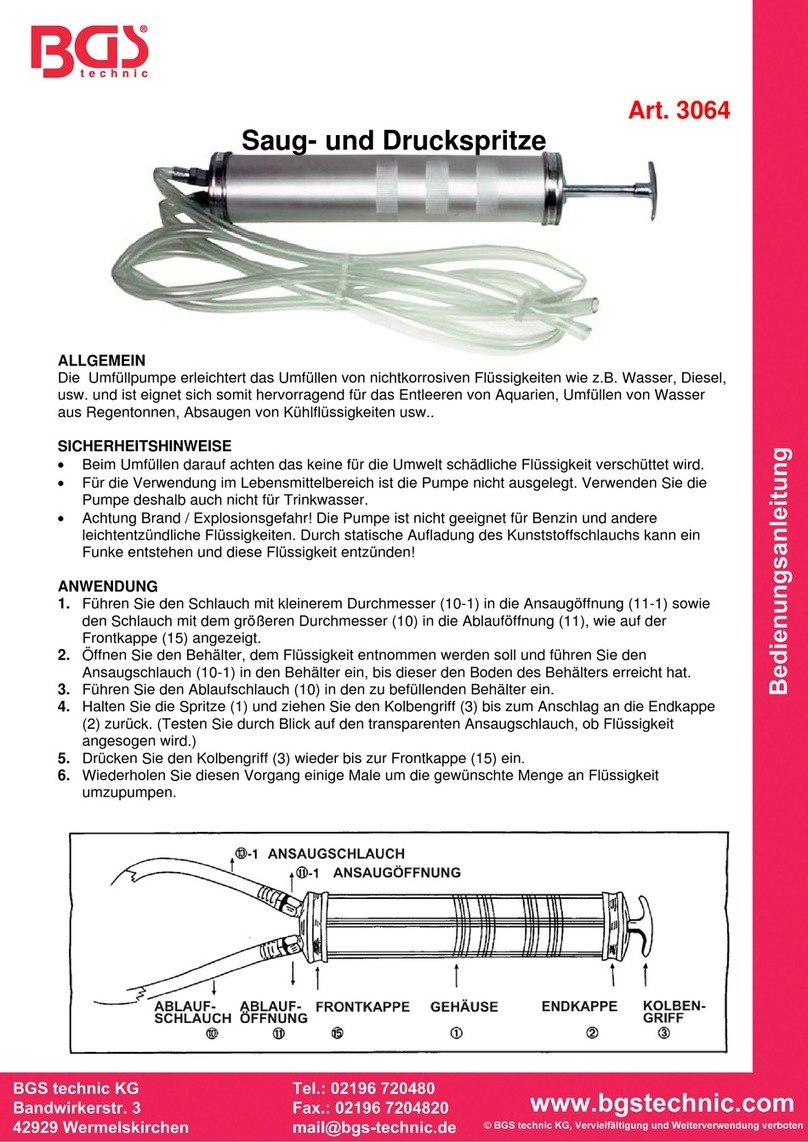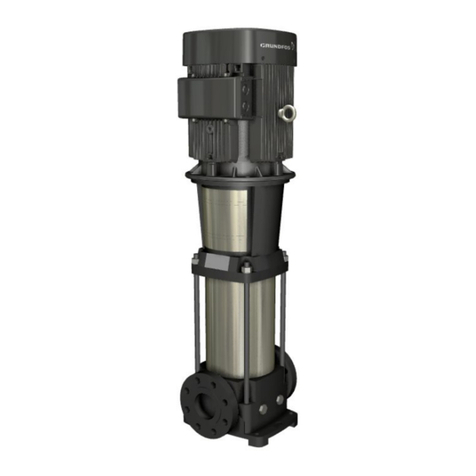Discount Equipment MAYCO ST-70 User manual

PARTS AND OPERATION MANUAL
Revision #4 (05/29/07)
MODEL ST-70
Structural Concrete Pump
(Hatz Diesel Engine)
THIS MANUAL MUST ACCOMPANYTHE EQUIPMENT AT ALLTIMES.
Go to Discount-Equipment.com to order your parts

Discount-Equipment.com is your online resource for quality parts & equipment.
Florida: 561-964-4949 Outside Florida TOLL FREE: 877-690-3101
Need parts?
Click on this link: http://www.discount-equipment.com/category/5443-parts/ and
choose one of the options to help get the right parts and equipment you are looking
for. Please have the machine model and serial number available in order to help us
get you the correct parts. If you don’t find the part on the website or on one of the
online manuals, please fill out the request form and one of our experienced staff
members will get back to you with a quote for the right part that your machine needs.
We sell worldwide for the brands: Genie, Terex, JLG, MultiQuip, Mikasa, Essick, Whiteman,
Mayco, Toro Stone, Diamond Products, Generac Magnum, Airman, Haulotte, Barreto,
Power Blanket, Nifty Lift, Atlas Copco, Chicago Pneumatic, Allmand, Miller Curber, Skyjack,
Lull, Skytrak, Tsurumi, Husquvarna Target, Stow, Wacker, Sakai, Mi-T-M, Sullair, Basic,
Dynapac, MBW, Weber, Bartell, Bennar Newman, Haulotte, Ditch Runner, Menegotti,
Morrison, Contec, Buddy, Crown, Edco, Wyco, Bomag, Laymor, EZ Trench, Bil-Jax, F.S.
Curtis, Gehl Pavers, Heli, Honda, ICS/PowerGrit, IHI, Partner, Imer, Clipper, MMD, Koshin,
Rice, CH&E, General Equipment ,Amida, Coleman, NAC, Gradall, Square Shooter, Kent,
Stanley, Tamco, Toku, Hatz, Kohler, Robin, Wisconsin, Northrock, Oztec, Toker TK, Rol-Air,
APT, Wylie, Ingersoll Rand / Doosan, Innovatech, Con X, Ammann, Mecalac, Makinex, Smith
Surface Prep,Small Line, Wanco, Yanmar

PAGE 2 — ST-70 — PARTS & OPERATION MANUAL — REV. #4 (05/29/07)
Diesel engine exhaust and some of
Go to Discount-Equipment.com to order your parts

PAGE 4 — ST-70 — PARTS & OPERATION MANUAL — REV. #4 (05/29/07)
Here's How To Get Help.......................................... 3
Table Of Contents ...................................................4
Parts Ordering Procedures ..................................... 5
ST-70
Specifications .......................................................... 6
Pump Warranty ....................................................... 7
Safety Instructions ............................................. 8-10
Important Hand Signals ........................................ 11
General Information......................................... 12-13
Concrete Mix Information ................................ 14-17
Slump Test Procedure........................................... 18
Operation (How it Works)...................................... 19
Initial Start-up Procedure................................. 22-25
Operating Procedures...................................... 26-30
Towing Information........................................... 31-33
Explanation Of Codes In Remarks Column .......... 34
Suggested Spare Parts......................................... 35
Decals Safety ................................................... 36-37
Component Illustrations
Control Panel Installation.................................38-39
Control Panel Front..........................................40-41
Control Panel Interior.......................................42-44
Main Drive Pumps ...........................................46-47
Manifold (Control) ............................................48-49
Accumulator.....................................................50-51
Hydraulic/Concrete Cylinders..........................52-53
Shuttle Tube Assy ............................................54-55
Hopper Assy ....................................................56-57
Remixer Control Assy ......................................58-59
Throttle Assy....................................................60-61
Engine and Frame ...........................................62-63
Oil Cooler Assy ................................................64-65
Fuel and Hydraulic Tank ..................................66-67
Battery,Tail Lights,Water Separator,Gauges ...68-69
Axle and Brakes...............................................70-71
Hydarulic Surge Brake and Hitch.....................72-73
TABLE OF CONTENTS
NOTE: Specification and part number
are subject to change without notice.
Service Information
Wiring Schematic:
1) Interior Control Panel (Inside Door)............... 74
2) Schematic Electrical Control Box .............. 75-76
3) Interconnect Electrical Control Box ................ 77
Hydraulic Diagram ........................................... 78-79
Optional Radio Control.......................................... 80
Safety Service Procedures ................................... 81
Maintenance Check Schedule ......................... 82-83
Pressure Setting Sequence .................................. 84
Accumulator Circuit............................................... 85
Hydraulic System Troubleshooting........................ 86
Electrical System................................................... 87
Changing Concrete Cylinder Piston Cups ............ 88
Changing the Wear Plate and Ring ...................... 89
Wheel Bearings..................................................... 90
Terms and Conditions Of Sale — Parts .................91
Go to Discount-Equipment.com to order your parts

PAGE 6 — ST-70 — PARTS & OPERATION MANUAL — REV. #4 (05/29/07)
ST-70 SPECIFICATIONS
PERFORMANCE U.S. METRIC
PumpingRate—VolumeOutput 70yd/hr.* (54m/hr)*
MaximumAggregateSize 11/2" minus (38mm)
Verticle PumpingHeight .................................................300 ft.*..................................................................... (91m)*
HorizontalPumping Distance .........................................1200ft.*................................................................... (366m)*
Engine— Diesel.............................................................HATZ 4M40L:80HP(59.68KW)
HopperCapacity 10cu.ft. capacitywithoptionalforward/reversere-mixer
Line Size ........................................................................3",4"or 5"dia.
ElectricalSystem ............................................................12 vD.C.
Hydraulic OilSystem ......................................................58 gal.
FuelTank Capacity .........................................................20 gal.
Weight (withfluids) .........................................................4700 lb.................................................................... (2132kg)
Tire Size .........................................................................7.35 - 14, 8 ply
Brakes ............................................................................12" dia.Hydraulic Surge
All SteelTrailer Frame
DIMENSIONS
L x W x H ........................................................................149"X67" X55"...................................................... (356X170X140cm)
Weight(Shipping)...........................................................4,700lbs. ................................................................ (2132kg)
*Thesefigures willvary with Pump Model, concrete mix design, line size,job site conditions and engine option.
Maycoreserves the right to change and modifythe abovespecifications ordesign without notice or obligation.
Go to Discount-Equipment.com to order your parts

ST-70 — PARTS & OPERATION MANUAL — REV. #4 (05/29/07) — PAGE 7
MAYCO PUMP WARRANTY
Mechanical Drive Models
MAYCO PUMP, hereinafter referred to as “Manufacturer’,
warrants each new Mayco Pump sold by the manufacturer to
be free from defects in material and workmanship, under
normaluse andservice, fora period of one year after the date
ofdelivery to the original retail purchaser.Manufacturer will, at
its option, replace or repair at a point designated by the
Manufacturer any part or parts which shall appear to the
satisfactionof the Manufacturer upon inspection at such point
to have been defective in material or workmanship. This
warranty does not obligate the Manufacturer to bear any
transportation charges or labor charges in connection with
the replacement or repair the of the defective parts.
This warranty does not apply to any pump if attempts have
been made to pump concrete materials which have
separated, to any pump which has been repaired with other
than Genuine Mayco Parts, nor to any pump which has been
altered,repairedorused in such mannerasto adversely affect
itsperformance,nortonormalserviceormaintenance orwhere
blockages have developed within the pump manifold or
placing line or which has been operated in any other manner
not recommended by the Manufacturer. Due to the abrasive
nature of concrete, Mayco does not cover natural component
wear.
THIS WARRANTY AND MANUFACTURER’S OBLIGATION
HEREUNDER, IS IN LIEU OF ALL OTHER WARRANTIES,
EXPRESS, IMPLIED OR STATUTORY AND ALL OTHER
OBLIGATIONS OR LIABILITIES INCLUDING SPECIAL OR
CONSEQUENTIALDAMAGESORCONTINGENTLIABILITIES
ARISING OUT OF THE FAILURE OF ANY PUMP OR PART
TO OPERATEPROPERLY,INCLUDING ANYWARRANTIES
OFMERCHANTABILITYOR FITNESSFOR APARTICULAR
PURPOSE.
Hydraulic Drive Models
MAYCO PUMP, hereinafter referred to as “Manufacturer”,
warrants each new Mayco Pump sold by the manufacturer to
be free from defects in material and workmanship, under
normaluseand service, fora period ofone year or2000 hours
after the date of delivery to the original retail purchaser.The
Manufacturer will, at its option, replace or repair at a point
designated by Manufacturer any part or parts which shall
appear to the satisfaction of Manufacturer upon inspection at
suchpoint to havebeen defective inmaterialor workmanship.
This warranty does not obligate Manufacturer to bear any
transportation charges or labor charges in connection with
the replacement or repair of the defective parts.
This warranty does not apply to any pump if attempts have
been made to pump concrete materials which have
separated, to any pump which has been repaired with other
than Genuine Mayco Parts, nor to any pump which has been
altered,repairedorused in such mannerasto adversely affect
it’s performance, nor to normal service or maintenance or
where blockages have developed within the pump manifold
orplacinglineorwhichhasbeenoperatedinanyother manner
not recommended by the Manufacturer. Due to the abrasive
nature of concrete, Mayco does not cover natural component
wear.
THIS WARRANTY AND MANUFACTURER’S OBLIGATION
HEREUNDER, IS IN LIEU OF ALL OTHER WARRANTIES,
EXPRESS, IMPLIED OR STATUTORY AND ALL OTHER
OBLIGATIONS OR LIABILITIES INCLUDING SPECIAL OR
CONSEQUENTIALDAMAGESORCONTINGENTLIABILITIES
ARISING OUT OF THE FAILURE OF ANY PUMP OR PART
TO OPERATEPROPERLY,INCLUDING ANYWARRANTIES
OFMERCHANTABILITYOR FITNESSFOR APARTICULAR
PURPOSE.
Go to Discount-Equipment.com to order your parts

PAGE 8 — ST-70 — PARTS & OPERATION MANUAL — REV. #4 (05/29/07)
READ THIS PARTS AND OPERATION MANUAL
THOROUGHLYBEFOREUSINGTHISMACHINE.Itdescribes
the safe, proper and most efficient way to operate it. KNOW
YOURMACHINE!
Whenoperating concrete pumpsthe safety regulations of
theresponsibleemployers’liabilityinsurancecompanymust
beobserved.The observationof these regulations shall be
theresponsibilityof the contractorandoperator.
Thefollowing are somesupplementary recommendations:
Allsafety devices andprovisions against accidentssuch as
warninglabelsand information signs,coverings, etc. must
beinplace. Do notremove or tamperwiththem. If theyare
missing,replacethem.
Check the operational reliability of the machine each time
before it is put into operation. Any defects found must be
repairedimmediately.
Allowthemachinetobeoperatedandmaintainedbyqualified
personnelonly.
Beforeleaving the machine, protect it fromunauthorizeduse
andunintentionalmovements.
Unauthorizedpresenceintheimmediateareaoftheconcrete
pumpisnotallowed.Warnpersonswhoareintheimmediate
area.Stopworkifpersonsdonotleavethearea after having
beenwarned.
Wear personal protective equipment when operating the
machine.
WW
WW
WARNING! DANGER OF AMPUTARNING! DANGER OF AMPUT
ARNING! DANGER OF AMPUTARNING! DANGER OF AMPUT
ARNING! DANGER OF AMPUTAA
AA
ATION!TION!
TION!TION!
TION!
Neverplaceyourhandsoranypartofyourbodyinthehopper
orallow anyoneelse to do so while the engine is runningor
whenthereisaccumulatorhydraulicpressureorseriesinjury
couldresult.
ST-70 — SAFETY INSTRUCTIONS
TRAVEL AND TRANSPORTATION
The machine must not be moved with extended outriggers.
Before traveling, check the transportation safety devices of
the outriggers, the tire pressure and the functioning of the
brakes.
Usehoistingunitswith transport devicescomplyingwith safety
requirements.
Hoisting cables or equipment are to be applied only at the
lifting points provided.
TOWING:
1. Read the Atwood Hydraulic Surge Brake Installation
Instructions.
2. The pump should not be towed in excess of 55 MPH (less
depending on road conditions). It can be towed with any
truck rated to pull a 5000 lb.load.
3. Before towing, check with local and state laws for proper
compliance.(Referto page 31)
a. Secure the hitch on the ball and attach the breakaway
cable and safety chain to the towing vehicle.
b. Raise all stand pipes and secure.
4. Use only a 2” one-piece, all-steel, machined or forged ball
ratedat 5000lbs.minimumcapacity.
5. Do not tow the pump with concrete in the hopper.
6. Do not tow the pump with the concrete reducers attached.
7. Checkallwheellugboltsforpropertightnesspriortotowing.
Go to Discount-Equipment.com to order your parts

ST-70 — PARTS & OPERATION MANUAL — REV. #4 (05/29/07) — PAGE 9
ST-70 — SAFETY INSTRUCTIONS
STABILIZER JACK
Priorto jackingcheckthe soil conditions.Ifnecessary,enlarge
thesupport foot areaby placingsquare timbers underneath.
Keepasufficientdistancefromexcavations;slopescouldbreak
awaybecauseof support pressures.
On inclines and slopes place chocks behind the wheels.
Jackthe pump insuch a manner that itis in ahorizontal (level)
position.Check the positionof thepump frequently.
CONCRETEPUMP
To avoid splashes due to suction of air, the agitator hopper
mustalways be filledwith concreteup to the mixing shaft.
DONOTOPERATEANYCONCRETEPUMP
WITHOUTTHEHOPPER GRILLFIRMLY IN
PLACE.
NEVER ALLOW ANY HANDS NEAR THE
SHUTTLE CRANK VALVE OR IN THE
AGITATORHOPPERWHILETHE MACHINE
ISRUNNING.
WARNING! DANGER OFWARNING! DANGER OF
WARNING! DANGER OFWARNING! DANGER OF
WARNING! DANGER OF
AMPUTAMPUT
AMPUTAMPUT
AMPUTAA
AA
ATION!TION!
TION!TION!
TION!
Never place your hands or any part of your
bodyinthehopper or allow anyoneelsetodo
so while the engine is running or when there
is accumulator hydraulic pressure or series
injurycouldresult.
Referto Operation sectionof thismanual for more details.
PIPELINES
PIPELINES AND CLAMPS MUST BE OF SUFFICIENT SIZE
FORTHEPUMP’S CAPACITY.
The pipeline connections must not be opened under working
pressure. Before the pipeline is opened, pressure must be
relieved by sucking back the concrete. Secure the couplings
afterthe assembly ofthe pipeline.
Whenlayingpipelineuse as fewbendsaspossible. Horizontal
pipelines must be adequately supported. When installing a
vertical pipeline, the best method is to use upright struts that
can be anchored to the building.
Itis preferable to install pipelineswithin thebuilding whenever
possible. See Operator’s Manual and “Pumping Concrete”
bookletsfor more information on pipeline installations.
MAINTENANCE AND REPAIR
TURN OFF THE ENGINE AND
DISCONNECT THE BATTERY CABLES
BEFORE PERFORMING ANY
MAINTENANCEOR REPAIRS.
MAKESURETHATTHEACCUMULATORPRESSUREGAUGE
READS ZERO BEFORE ALLOWING ANYBODY TO PUT
THEIRHANDSINTO HOPPERORSHUTTLE AREA.
Referto maintenance sectionof this manualfor moredetails.
CAUTION: If the hoses or lines are blocked for any
reason, or if the lines are kinked when
starting up or during the pumping cycle, the
pump pressure could straighten out the kink
or force out the blockage.This rapid surge of
materialcouldcausethelinestowhipormoveinsuchamanner
that it could cause injury to anyone working near the hosses
or lines.
When moving hoses from one site application to another, it is
important to walk the entire system and visually inspect for
anykinksor sharp bendsin thehose.Youmustand straighten
them before starting or resuming the pumping operation.
Inspect the lines at all times to prevent the above conditions.
Go to Discount-Equipment.com to order your parts

PAGE 10 — ST-70 — PARTS & OPERATION MANUAL — REV. #4 (05/29/07)
MODEL ST-70
THEOPERATORISINCOMPLETECHARGEOFTHEPUMP
ANDDELIVERY SYSTEM ANDIS RESPONSIBLEFOR HIS/
HEROWNSAFETYANDTOWARNANDKEEPALLOTHERS
OUT OF DANGER.
Do not attempt to operate this equipment without a
thorough understanding of this Parts and Operation
Manual:
1. To preventdamage to equipment orinjury to personnel,the
followinginstruction must befollowed carefully:
A. A copy of this manual and all others shall accompany the
pumpat all times.
B. This equipment shall be operated only by experienced
operators or students under the direct supervision of an
experienced operator.
C. No unauthorized persons shall be permitted to assist or
remain in the vicinity of the unit while it is in operation, or
duringthe, inspection,cleaningorrepairforthemake-ready
operation.
D. Thisequipmentshallnotbetowedoroperatedbyindividuals
who cannot read and understand the signs, decals or
operatinginstructions.
E. This equipment shallnot be operated by individuals under
the influence of alcohol or drugs.
F. Before towing, check the hitch and secure the breakaway
cable and safety chain to the towing vehicle.
G. Tow only with a vehicle and hitch rated to pull a 5000 lb.
load.
H. Use only a 2" one-piece, all-steel machined or forged ball
rated for a minimum of 5000 lbs.
I. Before start-up, check the hopper and remove all
obstructions.
J. Keep hands, feet and human body parts out of the hopper
when the engine is running.
K. The engine must be turned off before performing any
service operations. The engine is remote controlled and
may start pumping any time the engine is running.
L. Do not use worn hoses or hose couplings – inspect daily.
M. Replace any worn or damaged hoses, or couplings,
immediately.
N. Do not disconnect the hose couplings or nozzles while
under pressure.
ST-70 — SAFETY INSTRUCTIONS
O. Never fill the fuel tank while the engine is running or hot.
Avoid the possibility of spilled fuel which may cause a fire.
P. Always carry a fire extinguisher of adequate size and a
firstaid kit.
Q. Always wear a safety helmet and safety glasses when on
a job site pumping.
R. Always have the hopper grate securely in place when
pumping.
S. Pumpin reverse when the shuttlevalve ordelivery system
is plugged.
T. Guards, grates, covers, etc. MUST NOT be removed or
altered.
U. If a failure ormalfunction occurs,stop thepump and make
all necessary repairs immediately.
V. Electrical and manual controls must always be in working
order.
W. NEVER stand on the hopper grate.
X. Alwayspositionthepumponsafe,solid,levelground, using
the jack stands.
Go to Discount-Equipment.com to order your parts

ST-70 — PARTS & OPERATION MANUAL — REV. #4 (05/29/07) — PAGE 11
IMPORTANT HAND SIGNALS
Go to Discount-Equipment.com to order your parts

PAGE 12 — ST-70 — PARTS & OPERATION MANUAL — REV. #4 (05/29/07)
ST-70 — GENERAL INFORMATION
CONCRETE MIX DESIGN
Mixdesignismostimportant to achievemaximum pumpability.
Pumpability is affected by, among other factors, the type and
gradationofaggregateused.Naturalaggregatesmakea more
workablemix andpumpmorereadilythancrushedaggregates.
A blend of natural and crushed aggregates will produce a
workablemix.The typeand gradationof aggregates is equally
importantfor workabilityas thesize andpercentage ofcoarse
aggregatesin the mix.
Theterm“aggregates”describesallofthe solid materials, from
the largest rock to the smallest grain of sand, contained in the
concrete mix.
Concrete mixes with a consistency as dry as one-inch slump
and as wet as ten-inch slump have been pumped; but for
maximumefficiency from the pump,a slump ranging from two
to six inches will produce a more workable mix than one that
contains more or less water.
Aslumpratingshouldbe used with discretion;itisnotalways a
realindication ofthe pumpabilityof themix.The concrete may
be workable in the sense that it will readily flow into place, but
the same mix may not respond to pressure. Overly wet mixes
tendto separate.Inadditiontoaffectingthestrength andquality
oftheconcrete,thedeliverysystemwillnottolerateseparation.
Overlydrymixesaresimilarlyunsatisfactoryiftheylackplasticity
andtendtobecrumbly.Tobeproperlypumped,themixmustbe
abletocontinuouslycoatthe inside of thelinewithalubricating
sealof mortar.
Theprincipleof concrete pumpingis based onself-lubrication.
As it moves through the transfer line, the concrete takes the
shapeof aplastic cylinder.It isforcedthrough the transferline
on a film of mortar that is self-troweled to the service of the
transfer line around its full periphery by the slug of concrete
itself.
There are four ways in which this seal can be lost:
1. By pumping excessively wet mixes which do not have
enoughcohesion to hold together.
2. Bypumpingharshundersandedconcretewithpoorlygraded
aggregates which can jam together when the pressure
becomes too great for the insufficient amount of sand to
holdthe aggregates apart.
3. By getting a rock pocket, such as mixer tailings, into the
pumpvalve.Thisrockpocketwill haveaninsufficientcoating
ofmortarand the mixwillnot be plasticenoughto allow the
valveto operateor themix to move in the line.
4. Through excessive bleeding.If the mixisshort or fines,but
the sand is otherwise fairly well graded, bleeding will not
normallycreateanyproblemsaslongasthepumpcontinues
operation.But, if the pump isshutdown,bleedingcanresult
in a loss of lubrication and blocked erratic flow.
The above are bad concrete practices, regardless of how the
mix is to be placed. But, these points do show that special
mixes are not always needed, within limits, for pumping
concrete. Good aggregate gradation is most important to
pump concrete the maximum distance.
The use of admixtures can have a beneficial effect on
pumpability. Most of the dispersing agents will fatten, retard
bleeding,and increase workability.Thus,the averageconcrete
canbepumpedforappreciablylongerdistances.Airentraining
agents will also improve workability, although they cannot be
used as a substitute for good gradation of the aggregate.
Pumping will not appreciably affect the final air content of the
mix.High-earlycement tendstogive amorereadily pumpable
mix with superior water retaining qualities.However, if delays
are likely to occur, extra care must be exercised due to the
fastersettingtimeover regular cement.
The Mayco Model ST-70 will pump a wide variety of concrete
pump mixes. But, there are guidelines that must be followed.
Usethisinformation in conjunctionwith “The DeliverySystem”
on page 32, Sections 18 thru 18.10.
Go to Discount-Equipment.com to order your parts

ST-70 — PARTS & OPERATION MANUAL — REV. #4 (05/29/07) — PAGE 13
ST-70 — GENERAL INFORMATION
REGIONAL DIFFERENCES
Concrete is made by mixing locally available rock and sand
with cement and water. For this reason there are great
differences in the pumpability of concrete from one region of
the country to another.
Itis impossible to define a specific mixfor eachregion thatthe
ModelST-70 be will workingin.Therefore,the mixeson pages
14 through 17 will provide a basic guideline for establishing
the proper mix design for your area.
Usethis information to specify yourrequirements to your local
ready-mixbatchplant,contractorandcivilengineer.It maytake
minor adjustments to make a mix pumpable, so you should
explainyour needs.
The elements that have to be controlled and consistently
maintainedby the batch plant are:
1. The sizing and mix percentage of rocks, gap graded from
thelargest down throughthe smallest sizes.
2. Sandwith a sieve analysis that has the proper percentage
offines,ASTMC33 spec.
3. Sufficient cement to produce the required design strength
of the concrete and provide the lubricating binder to pump
theconcretethrough the delivery system.
Use a minimum of:
500 lbs.of cement/cu yd for 2500 p.s.i. concrete
after 28 days.
530 lbs.of cement/cu yd for 3000 p.s.i. concrete
after 28 days.
600 lbs.of cement/cu yd for 4000 p.s.i. concrete
after 28 days.
4. Admixture pump-aid if necessary.
5. The proper amount of water to make a workable slump
and plasticize the mix.
Inaddition,theMaycoStructural Concrete ST-70Pumpcanbe
usedto pumpa largeaggregate hard rock as follows:
1. Pea rock (1/2" minus) pump with mixes being as low as
30% rock and 70% sand. (See page 30, for comments on
cleaning the pump.)
2. Shortening pea rock when used with an air compressor
and nozzle. (See back pages for recommended set-up.)
3. “Mud Jacking”, high pressure grouting.
Go to Discount-Equipment.com to order your parts

PAGE 14 — ST-70 — PARTS & OPERATION MANUAL — REV. #4 (05/29/07)
ST-70 — CONCRETE MIX INFORMATION
JobIdentification* _______________________________________ Date* ______________________________________
Architect* ______________________________________________ GeneralContractor* ___________________________
StructuralEngineer*______________________________________ Concreteby* ________________________________
THEPROPORTIONSSHOWNHEREARE A RECOMMENDATION BASEDONTESTSOFSAMPLESRECEIVED BYTHE
LABORATORY.TESTS PERFORMED BY SUPPLIERS OR MANUFACTURERS OR ON PRIOR KNOWLEDGE OF THE
MATERIALSINVOLVED ANDISLIMITEDTOINFORMATIONDERIVEDFROMTHESE SAMPLESTESTSBYOTHERS OR
TOTHAT PRIOR KNOWLEDGE.
IT IS UNDERSTOOD THAT THE CHEMICAL AND/OR PHYSICAL CHARACTERISTICS OF THESE MATERIALS ARE
SUBJECTTOVARIATIONSTHATMAY ADVERSELYAFFECTTHEFINISHEDPRODUCTANDTHATTHISMIXDESIGNIS
NOT TO BE USED EXCEPT AT THE USERS OWN RISK UNLESS THESE VARIATIONS ARE DETERMINED AND
COMPENSATED FOR INAMANNER APPROVEDBYTHELABORATORYINWRITING.
Specificationsrequirements: 2500P.S.I. in 28 DAYS 3"SLUMP PUMPMIX 4"DIALINE
SIEVEANALYSIS PER CENT PASSINGU.S.STANDARD SIEVE
MATERIAL .........11/2............1...............3/4..................................................................................................................
FAIWCS.......................................................................100 ........97............84 ........... 70....... 45 ........25..... 10 ....... 97.5
FA2...................................................................................................................................................................................
CA1#4-3/8" ..............................................100.............95 ..........13............3 ............................................................... 90.5
CA2#3-1 ................................100...........96...............61 ..........6..............1 ............................................................... 91.0
CA3 ..................................................................................................................................................................................
...............................................100...........98...............85 ..........50............40 ........... 33....... 21 ........12..... 4 .........
Sourceof Coarse& FineAggregates -* Cement–Type* MixNo*
CementSks/Cu.Yd. ................................................................ 5.3
Cement–Lbs. ........................................................................ 500
Sand,Lbs.W.C.S. ................................................................... 1550
No.4Gravel (3/8"),Lbs. .......................................................... 500
No.3Gravel(1"), Lbs.............................................................. 1220
No.2Gravel(1-1/2"),Lbs........................................................
Water,Lbs............................................................................... 290
Total Weight........................................................................... 4060
Water,gal.peryd. ................................................................... 34.8
Water,gal./Sk.per yd. ............................................................. 6.5
Slump,calculated ................................................................... 3"
Admixture ............................................................................... 3fl. oz. POZZOLITH 300N/100 *OF CEMENT
Max.WaterAllowable ............................................................. *
*THIS INFORMATION PROVIDED BY ENGINEER OR BATCH PLANT
THE ABOVE MIX DESIGN IS TYPICAL OF A PUMPABLE MIX.TO BE USED AS A GUIDELINE ONLY. REFERTO LOCAL
AGENCY FOR JOB SPECIFICATION.
3-5
Go to Discount-Equipment.com to order your parts

ST-70 — PARTS & OPERATION MANUAL — REV. #4 (05/29/07) — PAGE 15
ST-70 — CONCRETE MIX INFORMATION
Job Identification* _______________________________________ Date* ______________________________________
Architect* ______________________________________________ General Contractor*___________________________
StructuralEngineer* _____________________________________ Concrete by* ________________________________
THEPROPORTIONSSHOWNHEREARE A RECOMMENDATION BASEDONTESTSOFSAMPLESRECEIVED BYTHE
LABORATORY.TESTS PERFORMED BY SUPPLIERS OR MANUFACTURERS OR ON PRIOR KNOWLEDGE OF THE
MATERIALSINVOLVED ANDISLIMITEDTOINFORMATIONDERIVEDFROMTHESE SAMPLESTESTSBYOTHERS OR
TOTHAT PRIOR KNOWLEDGE.
IT IS UNDERSTOOD THAT THE CHEMICAL AND/OR PHYSICAL CHARACTERISTICS OF THESE MATERIALS ARE
SUBJECTTOVARIATIONSTHATMAYADVERSELYAFFECTTHEFINISHEDPRODUCTANDTHATTHISMIXDESIGNIS
NOT TO BE USED EXCEPT AT THE USERS OWN RISK UNLESS THESE VARIATIONS ARE DETERMINED AND
COMPENSATEDFORIN A MANNERAPPROVED BYTHELABORATORYINWRITING.
Specificationsrequirements: 3000P.S.I. in 28 DAYS 4" SLUMP PUMPMIX 4"DIALINE
SIEVEANALYSIS PER CENT PASSING U.S.STANDARDSIEVE
MATERIAL .........11/2............1...............3/4..................................................................................................................
FAIWCS.......................................................................100 ........98............86 ........... 70....... 48 ........24..... 8 ......... 97.5
FA2...................................................................................................................................................................................
CA1#4-3/8" ..............................................100.............94 ..........16............4 ............................................................... 90.5
CA2#3-1 ................................100...........93...............57 ..........6..............1 ............................................................... 91.0
CA3 ..................................................................................................................................................................................
...............................................100...........97...............83 ..........51............41 ........... 33....... 23 ........11..... 4 .........
Sourceof Coarse& FineAggregates -* Cement–Type* MixNo*
CementSks/Cu.Yd. ................................................................ 5.
Cement–Lbs. ........................................................................ 525
Sand,Lbs.W.C.S. ................................................................... 1520
No.4Gravel (3/8"),Lbs. .......................................................... 480
No.3Gravel(1"), Lbs.............................................................. 1230
No.2Gravel(1-1/2"),Lbs........................................................
Water,Lbs............................................................................... 295
Total Weight.................................................................... 4050
Water,gal.peryd. ................................................................... 35.4
Water,gal./Sk.per yd. ............................................................. 6.3
Slump,calculated ................................................................... 4"
Admixture ............................................................................... 3fl. oz. POZZOLITH 300N/100 *OF CEMENT
Max.WaterAllowable ............................................................. *
*THIS INFORMATION PROVIDED BY ENGINEER OR BATCH PLANT
THE ABOVE MIX DESIGN ISTYPICAL OF A PUMPABLE MIX. TO BE USED AS A GUIDELINE ONLY. REFERTO LOCAL
AGENCY FOR JOB SPECIFICATION.
Go to Discount-Equipment.com to order your parts

PAGE 16 — ST-70 — PARTS & OPERATION MANUAL — REV. #4 (05/29/07)
ST-70 — CONCRETE MIX INFORMATION
Job Identification* _______________________________________ Date* ______________________________________
Architect* ______________________________________________ General Contractor*___________________________
StructuralEngineer* _____________________________________ Concrete by* ________________________________
THEPROPORTIONSSHOWNHEREARE A RECOMMENDATION BASEDONTESTSOFSAMPLESRECEIVED BYTHE
LABORATORY.TESTS PERFORMED BY SUPPLIERS OR MANUFACTURERS OR ON PRIOR KNOWLEDGE OF THE
MATERIALSINVOLVED ANDISLIMITEDTOINFORMATIONDERIVEDFROMTHESE SAMPLESTESTSBYOTHERS OR
TOTHAT PRIOR KNOWLEDGE.
IT IS UNDERSTOOD THAT THE CHEMICAL AND/OR PHYSICAL CHARACTERISTICS OF THESE MATERIALS ARE
SUBJECTTOVARIATIONSTHATMAY ADVERSELYAFFECTTHEFINISHEDPRODUCTANDTHATTHISMIXDESIGNIS
NOT TO BE USED EXCEPT AT THE USERS OWN RISK UNLESS THESE VARIATIONS ARE DETERMINED AND
COMPENSATED FOR INAMANNER APPROVEDBYTHELABORATORYINWRITING.
Specificationsrequirements: 4000P.S.I. in 28 DAYS 4"SLUMP PUMPMIX 5"DIALINE
SIEVEANALYSIS PER CENT PASSINGU.S.STANDARD SIEVE
MATERIAL .........11/2............1...............3/4..................................................................................................................
FAIWCS.......................................................................100 ........97............84 ........... 56....... 36 ........22..... 8 ......... 97.5
FA2...................................................................................................................................................................................
CA1#4-3/8" ..............................................100.............95 ..........13............3 ............................................................... 90.5
CA2#3-1 ................................100...........95...............64 ..........8..............1 ............................................................... 91.0
CA3 ................... 100 .............93.............64...............18 ..........2................................................................................. 90.0
..........................100 .............98.............90...............73 ..........49............40 ........... 26....... 17 ........10..... 4 .........
Sourceof Coarse& FineAggregates -* Cement–Type* MixNo*
CementSks/Cu.Yd. ................................................................ 6.4
Cement–Lbs. ........................................................................ 600
Sand,Lbs.W.C.S. ................................................................... 1480
No.4Gravel (3/8"),Lbs. .......................................................... 400
No.3Gravel(1"), Lbs.............................................................. 470
No.2Gravel(1-1/2"),Lbs........................................................ 800
Water,Lbs............................................................................... 300
Total Weight.................................................................... 4050
Water,gal.peryd. ................................................................... 36
Water,gal./Sk.per yd. ............................................................. 5.6
Slump,calculated ................................................................... 4"
Admixture ............................................................................... 3fl. oz. POZZOLITH 300N/100 *OF CEMENT
Max.WaterAllowable ............................................................. *
*THIS INFORMATION PROVIDED BY ENGINEER OR BATCH PLANT
THE ABOVE MIX DESIGN ISTYPICAL OF A PUMPABLE MIX. TO BE USED AS A GUIDELINE ONLY. REFERTO LOCAL
AGENCY FOR JOB SPECIFICATION.
Go to Discount-Equipment.com to order your parts

ST-70 — PARTS & OPERATION MANUAL — REV. #4 (05/29/07) — PAGE 17
ST-70 — CONCRETE MIX INFORMATION
Thesand content of pumpable concrete is very important. It is
one of the two major ingredients that change due to regional
location(the other is the rockor gravel).
Above is a typical sieve analysis of washed concrete sand
(W.C.S.)toA.S.T.M.C33specifications.
The total of the “Accumulated % Retained” is the Fineness
Modulus(F.M.).TheidealF.M.isbetween2.50and2.75,butthe
correctF.M.doesnotguaranteepumpability.Besideshavinga
correctF.M.thepercentageofsandbyweightthatpassesthrough
the No. 50 sieve must be between 15 and 30 and through the
No.100sieve5and10.The total of #50 and 100 mesh particles
mustbe between 25 and 35 percent.
This fine material plus the cement will provide the necessary
filmoflubricationtomovetheconcreteinsidethedeliverysystem.
DNASETERCNOC—SISYLANAEVEIS
EZISEVEIS 33CMTSA SCEPS SSAP% MUCCA 1#ELPMAS %VIDNI TER
4# 001-59 89 2 2
8 001-08 98 11 9
61 58-05 17 92 81
03 06-52 74 35 42
05 03-01 32 77 42
001 01-2 7 39 61
002
56.2=.M.FsuludoMsseneniF 56.2
Go to Discount-Equipment.com to order your parts

PAGE 18 — ST-70 — PARTS & OPERATION MANUAL — REV. #4 (05/29/07)
1.To obtain a representative sample, take samples at three or
more regular intervals throughout the discharge of the mixer
or truck.DO NOT take samples at the beginning or end of the
discharge.
2. Dampen the inside of the cone and place it on a smooth,
moist, nonabsorbent, level surface large enough to
accommodateboththeslumpedconcreteand the slump cone.
Stand on the “foot pieces” throughout the test procedure to
hold the cone firmly in place.
3.Fillthe cone
!/3
fullbyvolume and rod25times with a1/2"
dia x 24" lg. bullet-pointed steel rod. (This is a specific
requirement which will produce non-standard results unless
followedexactly.) Distributeroddingevenlyovertheentirecross
section of the sample. (See figure A.)
4.Fill cone another
!/3
which will makethe cone
@/3
fullby
volume.Rod thissecondlayer25timeswiththe rodpenetrating
into, but not through, the first layer. Distribute rodding evenly
over the entire cross section of the layer.(See figure B.)
5. Fill cone to overflowing. Rod this layer 25 times with rod
penetrating into but not through, the second layer. Distribute
rodding evenly over the entire cross section of this layer.(See
figureC.)
6.Removetheexcess concrete from thetopofthe cone, using
the tamping rod as a screed.(See figure D.)
7. Lift the cone vertically with a slow even motion. Do not jar
the concrete or tilt the cone during this process. (See figure
E.) Invert the withdrawn cone, and place it next to, but not
touching the slumped concrete.
8. Lay a straight edge across the top of the slumped cone.
Measure the amount of slump in inches from the bottom of
the straight edge to the top of the slumped concrete at a point
over the original center of the base (See Figure F).The slump
operation must be complete in a maximum elapsed time of 1-
½ minutes.Discard the concrete.DO NOT use it in any other
tests.
SLUMPTEST PROCEDURE
Go to Discount-Equipment.com to order your parts

ST-70 — PARTS & OPERATION MANUAL — REV. #4 (05/29/07) — PAGE 19
ST-70 — OPERATION (How itWorks)
The following is a brief explanation of
how the concrete cylinders, hydraulic
cylinders, shuttle tube, valves and
hopper work in sequence to pump
concrete.
The hydraulic pressure is generated by
a variable volume, pressure
compensated, axial piston pump that is
driven by a diesel engine.The hydraulic
pressure is applied to one of the two
hydraulic cylinders causing the
hydraulic piston, which is connected to
the concrete piston, to discharge
concrete into the delivery line.The rod
sides of the drive cylinders are
hydraulically connected together
creatinga“slavecircuit.”Asone cylinder
isdischargingconcrete, the hydraulicoil
from the rod side of the drive cylinders
is being transferred through the slave
circuit causing the opposite cylinder to
move back on the suction stroke filling
the cylinder with concrete. This
operation is made possible by the
shuttle tube located in the hopper and
is sequenced to operate in conjunction
with the cycling of the drive cylinders.
The ST-70 cycling sequence is initiated
by an electrical signal generated by two
proximity switches located in the drive
cylinder. The proximity switches are
normallyopen,magneticallysensingthe
movement ofthe maindrivecylinder.As
the drive cylinder piston head passes
theproximity switch, an electrical signal
is sent to the solenoid operated pilot
valve which in turn directs pilot oil to the
fourvalves controllingthe drive cylinder
and the shuttle cylinder.
A one-gallon accumulator assists the
movementoftheshuttletube.This circuit
assures that the shuttle tube will throw
with the same intensity of each stroke
regardless of how fast the main drive
cylinders are cycling.
TO TANK HIGH PRESSURE
OIL FROM PUMP TO TANK
HYDRAULIC
CYLINDERS
PISTON
CUP
CONCRETE
CYLINDERS
SLAVE
OIL
SLAVE
OIL
AA
BB
Figure 1
CYLINDER A — INTAKE STROKE
CYLINDER B — DISCHARGE STROKE CYLINDER A — DISCHARGE STROKE
CYLINDER B — INTAKE STROKE
Figure 2
PROXIMITY SWITCH
PROXIMITY
SWITCH
SHUTTLE TUBE
Go to Discount-Equipment.com to order your parts

PAGE 20 — ST-70 — PARTS & OPERATION MANUAL — REV. #4 (05/29/07)
This section is intended to assist the operator with the initial
start-up of the MAYCO ST-70 Concrete Pump.It is extremely
important that this section be read carefully beforeattempting
to use the pump in the field.
DO NOT proceed to the Operating Procedures (field use) of
this manual until this section is thoroughly understood.
NOTE:
Failure to understand the operation of the MAYCO ST-70
Concrete pump could result in severe damage to the pump or
personalinjury.
Figure1 illustratesthe basicoperating controlsand indicators
on the MAYCO ST-70 Concrete pump. Each of the items
referenced will bediscussed.Thesequencewill beas follows:
1. Engine Oil
2. Hydraulic Oil
3. Fuel
4. Rear Stabilizer Stands
5. Emergency Stop Switch
6. Ignition Switch
7. Status Indicators
8. Control Switch, EngineThrottle Control
9. Volume Control
10. Engine Speed, Cooling Fan
11. PressureTest
12. Hopper RemixerControl Lever
13. Manual and Radio Control
14. Cylinder Lubrication
INITIAL START-UP PROCEDURE
Figure 1. MAYCO ST–70
Controls and Indicators
Go to Discount-Equipment.com to order your parts

ST-70 — PARTS & OPERATION MANUAL — REV. #4 (05/29/07) — PAGE 21
Engine Oil
1. Pull the engine oil dipstick from the engine side panel as
shown in Figure 2.
Determineif engineoil islow.Ifoil level is low, addcorrect
amount of engine oil to bring oil level to a normal safe
operating level. See Figure 3.
If the hydraulic oil level is low, remove the cap just above
the oil level sight glass and add the correct amount of
hydraulic oil to bring the hydraulic oil level to a normal
safe operating level.(Use Shell oilTellus 68 or Mobil oil
DFE26)
FUEL
3. Determine if engine fuel is low (Figure 5). If fuel level is
low, remove the fuel filler cap and fill with diesel fuel.
Figure 3.
Engine Oil Dipstick
MAX
MIN
ADD ENGINE OIL
SAFE OPERATING
OIL LEVEL
OIL DIPSTICK
Figure 4.
Hydraulic Oil Sight Glass
150
200
250
150
100
50
0
F
H
L
I
O
G
W
H
HYDRAULIC
OIL LEVEL
SIGHT GLASS
NORMAL LEVEL
LOW LEVEL
ADD OIL
HYDRAULIC OIL
TEMPERATURE
GAUGE
OIL DIPSTICK
OIL FILTER
THROTTLE
CABLE
SOLENOID
ENGINE
SIDE PANEL
RED (POSITIVE)
WHITE (NEGATIVE
Figure 2.
Engine Oil
INITIAL START-UP PROCEDURE
Hydraulic Oil
2. Determine if the hydraulic oil levelis low by observing the
level of the oil in the Hydraulic Oil Sight Glass (Figure 4).
REAR STABILIZER STAND
ToreduceexcessivevibrationandrockingoftheST-70Concrete
Pumpset the rearstabilizer as follows:
4. Locate both left and right rear stabilizerstands (Figure6).
Figure 6.
Rear Stabilizer Stand
COTTER PIN
BOLT EYE
REAR STABILIZER STAND
HANDLE TEE BOLT
STABILIZER FOOT PAD
A. Remove the
cotter pin
from the handle tee bolt eye, and
then
pull
the handle tee to release the stabilizer stand.
B. Positionbothrearstabilizersstandsonfirm(notloose)
level
ground.
C. Align the hole on the stabilizer stand with the hole on the
framebody and
insert
handle teebolt.
Figure 5.
Fuel Sight Tube
Go to Discount-Equipment.com to order your parts
Table of contents
Popular Water Pump manuals by other brands
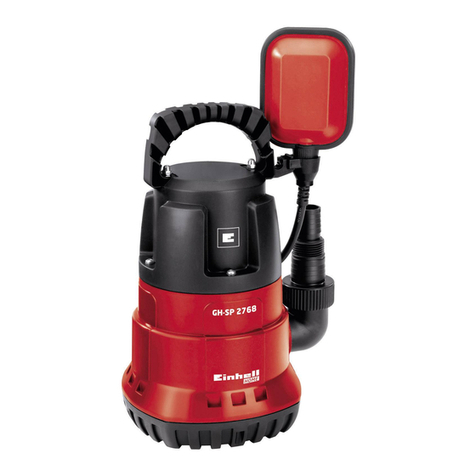
EINHELL
EINHELL GH-SP 2768 Original operating instructions
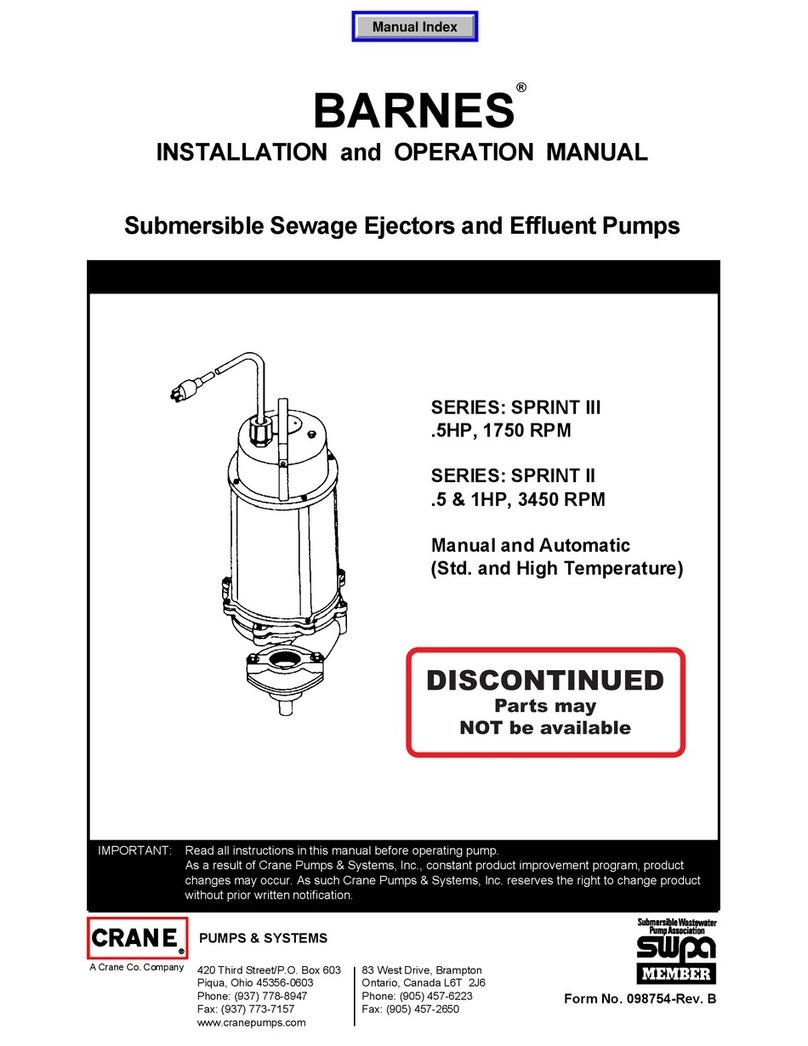
Crane
Crane Barnes SPRINT III Series Installation and operation manual
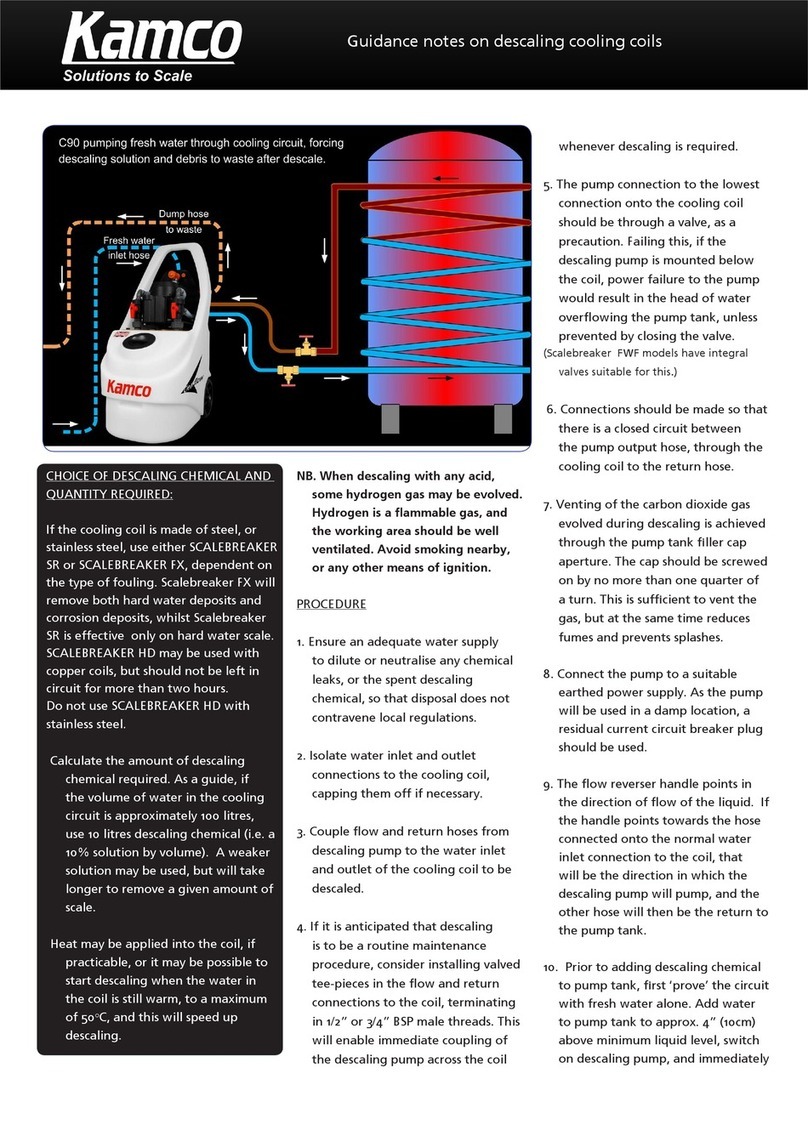
Kamco
Kamco C90 Guidance notes
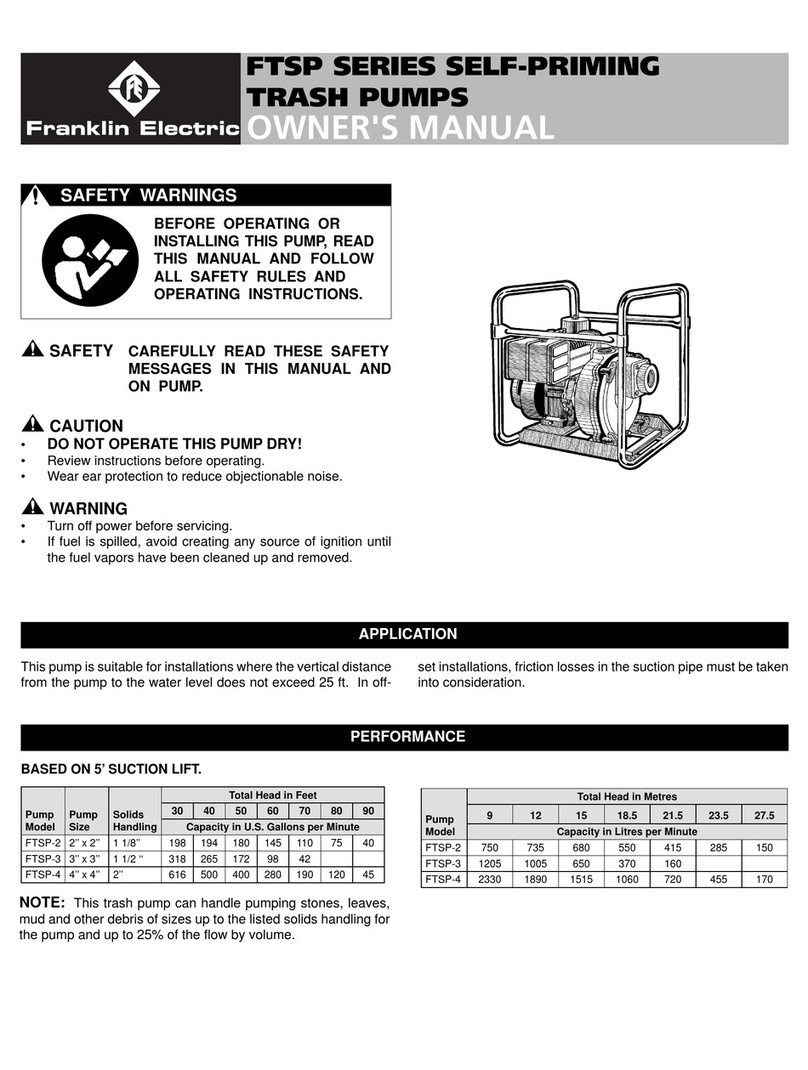
Franklin Electric
Franklin Electric FTSP Series owner's manual
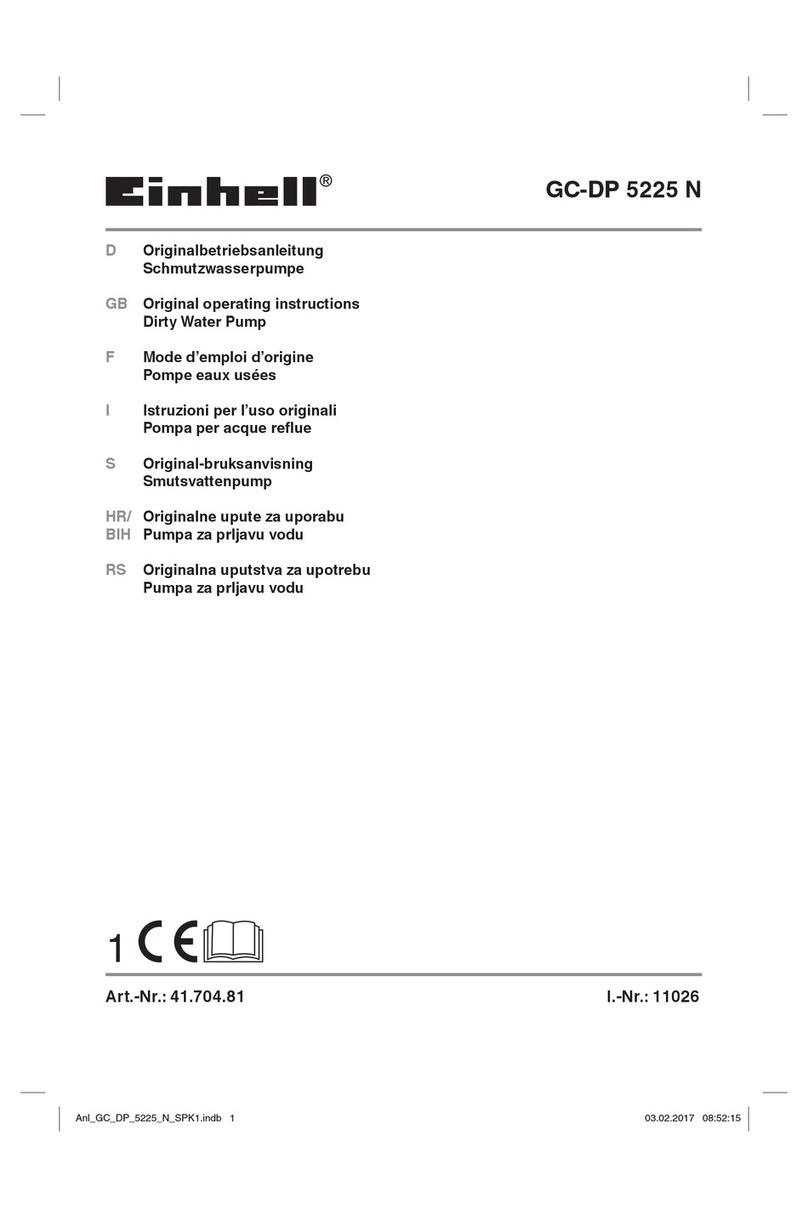
EINHELL
EINHELL GC-DP 5225 N operating instructions
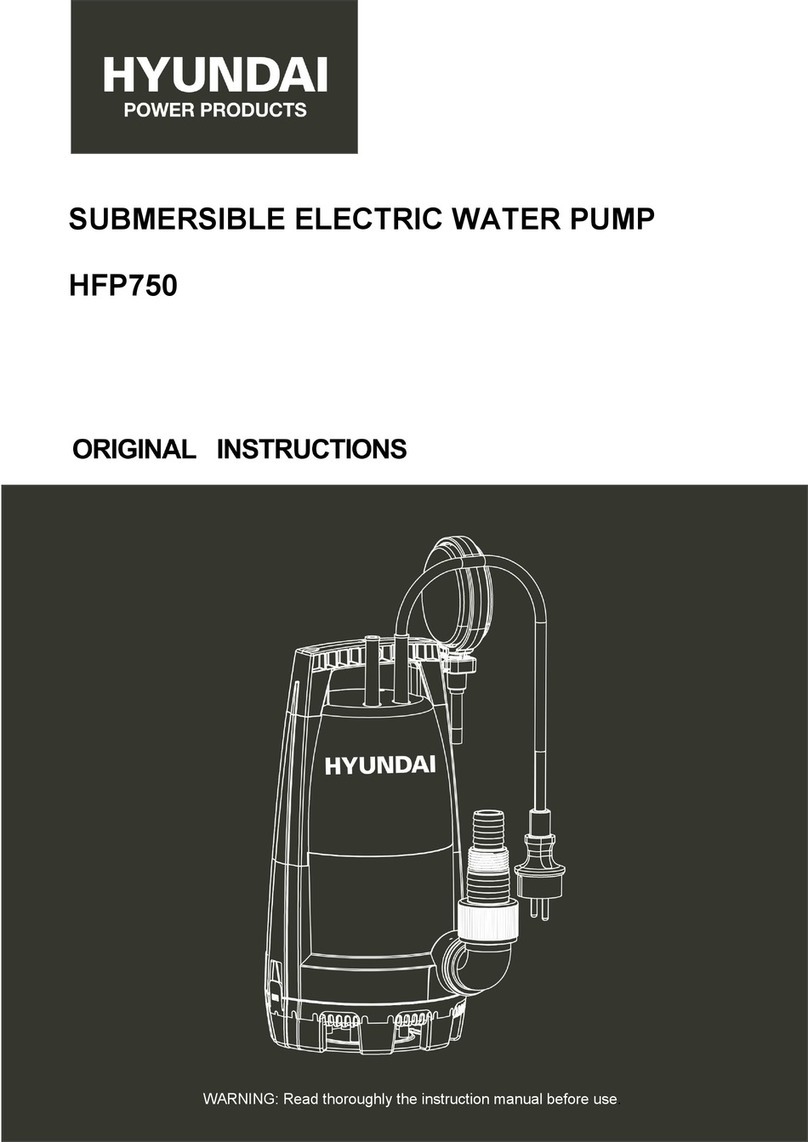
Hyundai power products
Hyundai power products HFP750 Original instructions

Milwaukee
Milwaukee M18 Operator's manual

Liberty Pumps
Liberty Pumps LEH150-E Series owner's manual
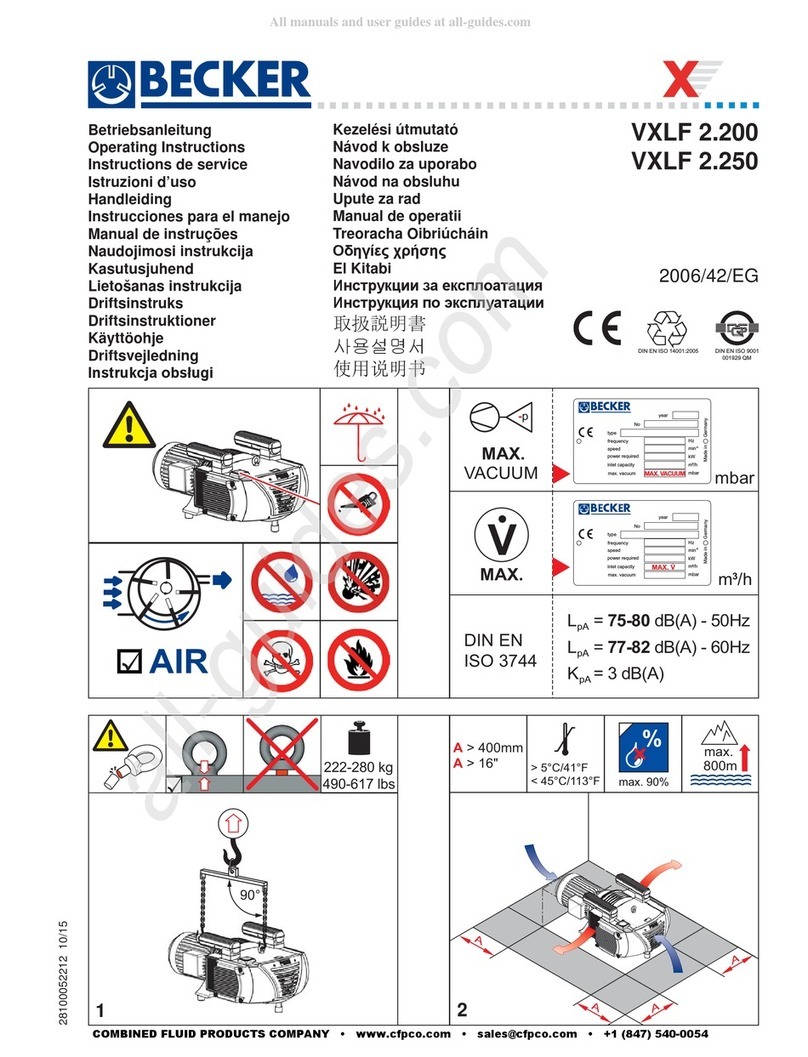
Becker
Becker VXLF 2.200 operating instructions

Ingersoll-Rand
Ingersoll-Rand PD05P series Operator's manual

Makita
Makita DVP181ZK instruction manual
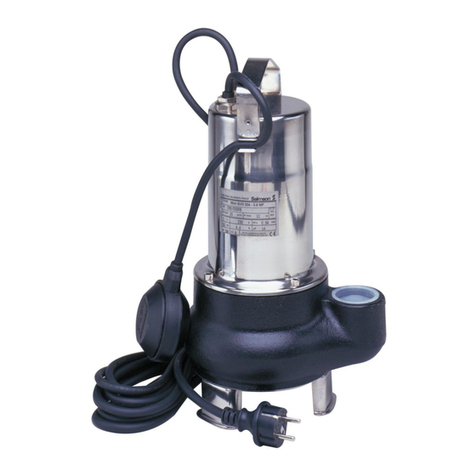
salmson
salmson Mini-SVO Installation and starting instructions



